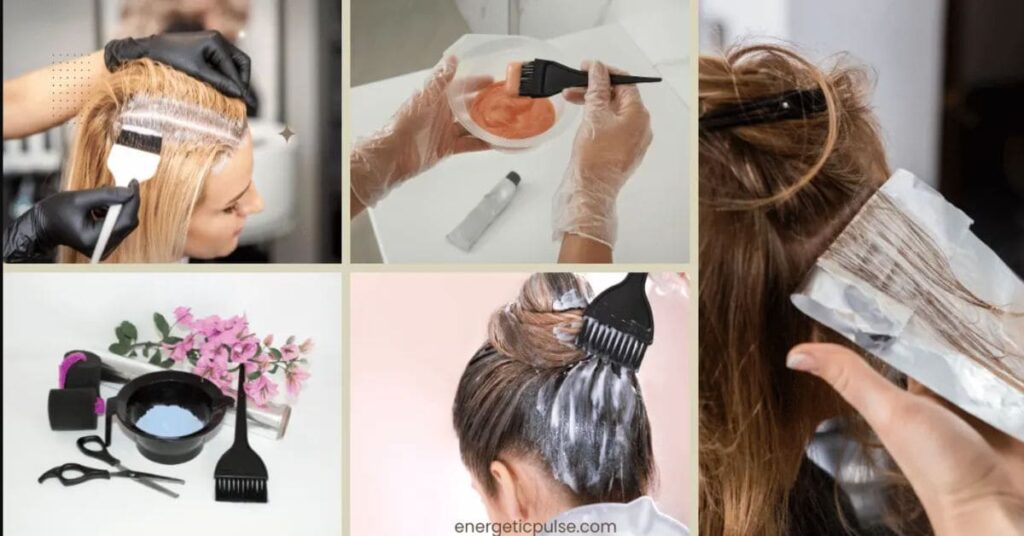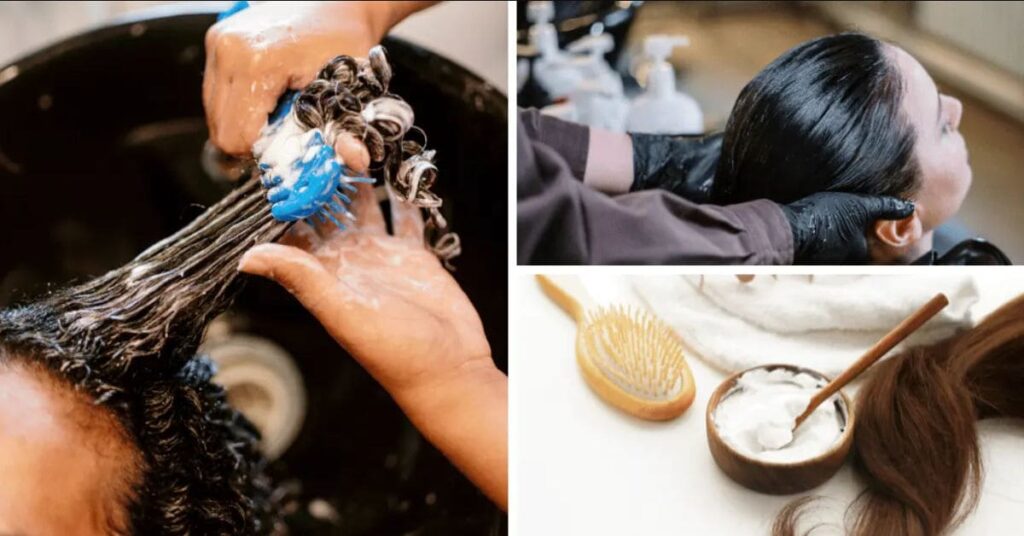Effective communication with your hair colorist is important for achieving the hairstyle you desire. We’ll provide you with practical tips and strategies to confidently express your preferences, understand salon movement, and ensure a satisfying salon experience. Whether you’re seeking a soft change or a bold transformation, mastering these communication techniques will empower you to articulate your vision and collaborate effectively with your stylist.
Preparation and Communication Techniques for Effective Salon Visits
It takes more than just turning up to the salon; preparation also includes arming yourself with the knowledge and resources you need to interact with your hair colorist. By following this practical advice and using efficient communication techniques, you can ensure a smooth and successful salon experience.
Providing Inspiration with Images:
Obtain images that best represent the hairstyle or color you want before you visit the salon. Images from magazines, social media, or even celebrities with hair you like could be included in this. With the help of visual aids, your hair colorist can more easily realize your vision by having a clear understanding of your preferences.
Being Honest About Hair History:
To make decisions regarding color treatments, your hair colorist must be aware of your hair’s past. Be open and honest about any past hair damage, coloring, or chemical treatments. With the use of this knowledge, your colorist can select the best products and methods for your type and condition of hair, maximizing benefits and reducing the risk of damage.
Sharing Lifestyle and Maintenance Routine:
Tell your colorist about your daily hair care regimen and lifestyle choices. Hair color and style choices can be influenced by a number of factors, including how frequently you wash your hair, your personal styling preferences, and your willingness to put up the time and effort necessary for maintenance. Your colorist can suggest low-maintenance options that fit your needs and preferences by getting to know your lifestyle.
Seeking Professional Advice:
Although it’s important to bring your ideas and preferences with you, don’t be afraid to ask your hair colorist for expert advice. Their proficiency and understanding enable them to evaluate the state of your hair, determine whether specific colors or treatments are appropriate, and provide insightful advice. You can achieve better results and a hairstyle that accentuates your features and personality by putting your trust in your colorist’s expertise.
By following these preparation and communication techniques, you can ensure a productive and satisfying salon visit. Effective communication with your hair colorist lays the foundation for achieving your desired hairstyle while fostering a collaborative relationship built on trust and understanding.
Enhancing Communication with Hairstylists or Barbers
Effective communication with your hairstylist or barber is essential for achieving the desired haircut or style. By employing specific strategies and techniques, you can ensure that your expectations are met and that you leave the salon feeling satisfied with your new look.
Utilizing Visual References:
Visual aids like pictures or magazine clippings can be very helpful in explaining to your stylist the type of hairstyle you want. Show your stylist pictures of hairstyles that you like or that closely resemble the look you want to achieve, rather than relying just on verbal descriptions. By offering a clear point of reference, this visual aid reduces the possibility of misunderstandings and guarantees that you and your stylist are in agreement.
Using Appropriate Terminology:
To effectively communicate with your stylist, become familiar with basic terminology used in hairstyling. For instance, be more specific about the length or style you have in mind by describing it as “a textured pixie cut” or “shoulder-length layers,” as opposed to utilizing general terms like “short” or “long.” Speaking clearly facilitates communication and enables your stylist to precisely create the look you want.
Articulating Issues and Solutions:
Don’t be afraid to express to your stylist any particular worries or preferences you may have about your hair. Be honest about what you liked and didn’t like about a previous haircut, whether it’s addressing it or asking for a different styling method. Furthermore, provide constructive criticism and ideas for enhancement to encourage a cooperative conversation with your stylist.
Preparing Ahead and Observing Stylist Reactions:
Think about the results you want your hairstyle to achieve before your appointment. Take into account elements like your hair type, face shape, and personal style preferences. Throughout the appointment, observe your stylist’s responses and comments. Pay close attention to what they have to say and be receptive to their expertise if they voice any concerns or suggest other ideas. Keep in mind that getting your hair done is a team effort, and your stylist’s advice can help you fine-tune your vision for the finished look.
You can successfully communicate your preferences for a hairstyle to your stylist or barber and guarantee a positive salon experience by applying these techniques for communication.
Building a good rapport with your stylist through open and honest communication helps them better customize their services to your preferences and needs.
Practical Tips for Interacting During the Haircut

To get the desired effect and make sure you’re happy with the way your hair looks in the end, you need to communicate effectively with your stylist or barber during the haircut. You can actively participate in the hairstyling process and express your preferences with clarity by adhering to these helpful pointers and guidelines.
Speaking Up During the Process:
If you have any comments or concerns during the haircut, don’t be afraid to voice them. Communication is essential, regardless of your preferences for a particular styling technique, the amount of hair you want removed, or the areas you’d like your stylist to concentrate on. Don’t be afraid to express your opinions to your stylist at any point during the process; they rely on it to customize the haircut to your tastes.
Asking Questions and Being Specific:
Never be afraid to ask questions in order to get clarification if you have any questions about any aspect of the haircut. Your stylist is there to offer advice and information on anything from the chosen hairstyle to the tools or techniques being used to the products suggested for styling and upkeep. Furthermore, be clear about what you want and use precise language to express your preferences.
Requesting a Mirror for Feedback:
You can give real-time feedback and make sure the haircut is going as planned by asking for a mirror when getting a haircut. Examine the haircut from several perspectives and let your stylist know if you think it needs to be adjusted. This honest communication makes it easier for you and your stylist to work together to create a haircut that fulfills your needs.
Expressing Gratitude and Feedback:
Once the haircut is finished, thank your stylist for their hard work and expertise. Inform them if you’re happy with the outcome, and as a thank you, think about giving them a nice review or tip. Alternatively, politely and constructively express your dissatisfaction with any parts of the haircut that you find lacking. Your stylist will value your candor and openness in sharing feedback, which will enable them to resolve any issues and guarantee your satisfaction.
You can effectively collaborate with your stylist or barber and actively participate in the hairstyling process by heeding these helpful tips for interacting during the haircut. A good experience at the salon and a hairstyle that suits your tastes and personality are largely dependent on open communication, constructive criticism, and respect for one another.
Communication Strategies for Hairstylists
Effective communication is important for hairstylists to comprehend client needs, provide outstanding service, and create enduring relationships. You can guarantee your clients’ satisfaction with their hairstyle outcomes and give them a positive salon experience through the use of focused communication tactics and strategies.
Practicing Active Listening:
Throughout the consultation process, pay close attention to the expectations, preferences, and concerns of your clients. Focus entirely on them, keep your eyes on them, and listen to them sympathetically to find out what kind of hairstyle they would like and if they have any special requests. To make sure everyone understands and to show that you are committed to meeting their needs, reiterate the most important points.
Employing Open-Ended Questions:
Encourage your clients to express themselves and provide specific information about their preferred hairstyles by asking open-ended questions. Ask open-ended questions that stimulate discussion and let clients go into further detail about their goals rather than closed-ended inquiries. Asking questions like “How do you envision styling your hair on a daily basis?” or “Tell me about any past experiences with haircuts or colors that you’ve loved” are some examples of questions you could ask.
Making Use of Visual References and Offering Professional Guidance:
To help clients visualize their desired hairstyle and to facilitate communication, use visual aids like color swatches, digital lookbooks, and hairstyle magazines. Provide them with professional guidance on what colors, cuts, and styling methods would go well with their skin tone, face shape, and way of life in addition to demonstrating hairstyles that suit their tastes. Make use of your knowledge to assist them in selecting a hairstyle that suits them.
Managing Client Expectations:
When it comes to the results of your clients’ hairstyling services, set reasonable expectations. Talk about any restrictions or difficulties that might occur due to their hair type, texture, or condition, and be honest about what is realistic given their desired timeframe and financial constraints. You can prevent misunderstandings and guarantee that clients are happy with the outcome by setting clear expectations upfront.
You can foster a supportive and cooperative salon environment where clients feel heard, respected, and secure in their hairstyle decisions by putting these communication techniques into practice. In addition to strengthening the client-stylist bond, good communication builds loyalty and trust, which promotes long-term success in the salon sector.
Conclusion
In summary, good communication between clients and hairstylists is essential for a successful salon visit. Hairdressers can listen intently and offer knowledgeable guidance; clients can use the advice to clearly communicate their preferences. The client-stylist relationship is strengthened by this collaborative approach, which also yields satisfactory results. Both parties can benefit from clear communication, which is essential to guaranteeing a great salon experience and getting the desired hairstyle.


